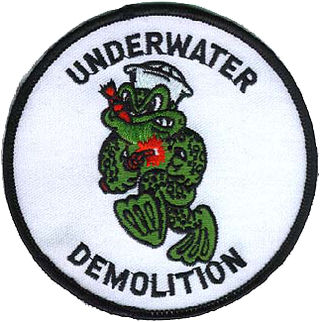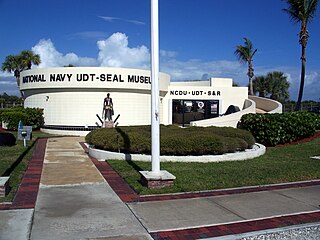
The United States Navy Sea, Air, and Land (SEAL) Teams, commonly known as Navy SEALs, are the U.S. Navy's primary special operations force and a component of the Naval Special Warfare Command. Among the SEALs' main functions are conducting small-unit special operation missions in maritime, jungle, urban, arctic, mountainous, and desert environments. SEALs are typically ordered to capture or kill high level targets, or to gather intelligence behind enemy lines. SEAL team personnel are hand selected, highly trained, and possess a high degree of proficiency in direct action (DA), and special reconnaissance (SR), among other tasks like sabotage, demolition, intelligence gathering, and hydro-graphic reconnaissance, training, and advising friendly militaries or other forces.

A frogman is someone who is trained in scuba diving or swimming underwater in a tactical capacity that includes military, and in some European countries, police work. Such personnel are also known by the more formal names of combat diver, combatant diver, or combat swimmer. The word frogman first arose in the stage name The Fearless Frogman of Paul Boyton in the 1870s and later was claimed by John Spence, an enlisted member of the U.S. Navy and member of the OSS Maritime Unit, to have been applied to him while he was training in a green waterproof suit.

Underwater Demolition Team (UDT), or frogmen, were amphibious units created by the United States Navy during World War II with specialized non-tactical missions. They were predecessors of the navy's current SEAL teams.

The United States Naval Special Warfare Command (USNSWC), also known as, is the naval component of United States Special Operations Command, the unified command responsible for overseeing and conducting the nation's special operations and missions.

USS Kleinsmith (APD-134), ex-DE-718, was a Crosley-class high speed transport for the United States Navy. She was named for Chief Watertender Charles Kleinsmith (1904–1942), who was posthumously awarded the Navy Cross for his heroism during the Battle of Midway.

Gary Fred Merrill was an American film and television actor whose credits included more than 50 feature films, a half-dozen mostly short-lived TV series, and dozens of television guest appearances. He starred in All About Eve and married his costar Bette Davis.

The Russian commando frogmen, informally called "commando frogmen" in civilian media, are a Russian Naval Spetsnaz unit under operational subordination to the Main Intelligence Directorate (GRU). It is the special forces unit of the Russian Naval Infantry and is composed of highly trained and elite marines within the Naval Infantry. By virtue of belonging to the Russian Naval Infantry, frogmen fall under the Coastal Troops of the Russian Navy service arm. The Russian Navy proper does not field any special forces or special operations units. Russian FSB special forces Alpha Group and Vympel also have frogman units in their respective naval components.

The Kopaska is the premier frogman and underwater demolition unit of the Indonesian Navy. The unit's motto is in Sanskrit: Tan Hana Wighna Tan Sirna. The unit's main duties are underwater demolition, destroying main underwater installations, reconnaissance, prisoner snatches, preparing beaches for larger naval amphibious operations, and counter-terrorism. During peacetime, the unit also deploys a team to serve as security personnel for VIPs and VVIPs. The personnel of Kopaska are recruited from Indonesian Navy seamen. Like other Indonesian special forces, Kopaska is trained to be able to conduct operations in the sea, including underwater, on land and airborne.

USS Begor (DE-711/APD-127) was a Crosley-class high speed transport of the United States Navy.

USS Hopping (DE-155) was a Buckley-class destroyer escort in service with the United States Navy from 1943 to 1947. In 1944, she was converted to a Charles Lawrence-class high speed transport and redesignated "APD-51". She was sold for scrap in 1966.

USS Taconic (AGC-17/LCC-17) was an Adirondack class amphibious force command ship of the U.S. Navy named after the Taconic Mountains in New York. She was laid down in December 1944 and decommissioned in January 1969.

Submarine Command is a 1951 American war film directed by John Farrow and starring William Holden, Don Taylor, Nancy Olson, William Bendix, and Darryl Hickman. It is notable for being one of the first films to touch on post traumatic stress disorder. Holden invested $20,000 of his own money into the film. The film received a mixed reception: it was panned by some critics for its brooding melodrama whilst being praised by others.

Roy H. Boehm was born in Brooklyn, New York and was a veteran of 30 years of military service in the United States Navy, serving in three wars and various clandestine operations. Boehm was a mustang officer who rose up from the enlisted ranks and was commissioned to develop and lead what would become the US Navy SEALs as the first Officer In Charge of SEAL Team Two.

Destination Gobi is a 1953 American Technicolor World War II film released by 20th Century-Fox. It was produced by Stanley Rubin, directed by Robert Wise, and stars Richard Widmark and Don Taylor.

The National Navy UDT-SEAL Museum, also known as the Navy SEAL Museum, is located in St. Lucie County, just outside Fort Pierce, Florida. It houses exhibits to inform and educate on the role of Navy Underwater Demolition Teams (UDT) and Sea, Air, Land (SEAL) teams. The museum also preserves the history of the SEALs.

The US employs divers in several branches of the armed forces, including the navy, army, marines, air force and coast guard.

USS Hollis (DE-794/APD-86) was a Buckley-class destroyer escort in service with the United States Navy from 1944 to 1947 and from 1951 to 1956. She was scrapped in 1975.
Operation Thunderhead was a highly classified combat mission conducted by U.S. Navy SEAL Team One and Underwater Demolition Team 11 (UDT-11) in 1972. The mission was conducted off the coast of North Vietnam during the Vietnam War to rescue two U.S. airmen said to be escaping from a prisoner of war prison in Hanoi. The prisoners, including Air Force Colonel John A. Dramesi were planning to steal a boat and travel down the Red River to the Gulf of Tonkin.
John Pitts Spence was an American diver for the United States Navy and World War II veteran who is widely credited as the country's first combat frogman. Spence was the first enlisted man to be recruited into a clandestine group, operated by General William "Wild Bill" Donovan of the Office of Strategic Services (OSS), which would become known as the frogmen. The group was a predecessor of the present-day United States Navy SEALs.
















